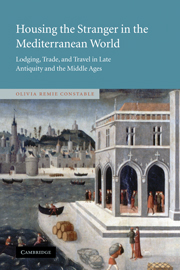 Housing the Stranger in the Mediterranean World
Housing the Stranger in the Mediterranean World Published online by Cambridge University Press: 27 August 2009
Muslim commercial institutions that had taken shape in the early Islamic period continued to evolve and thrive in the later middle ages. The large volume of business coming through the funduqs, fondacos, and other facilities in Egypt, Syria, and the Maghrib is attested in a wide range of sources from the second half of the thirteenth century through the first decades of the sixteenth century. The Mamlūk historian al-Maqrīzī (1364–1442) described the Funduq Bilāl al-Mughīthī in Cairo where “merchants and businessmen store their goods … I entered one day and saw their crates, large and small, lined up against the wall, leaving only a narrow passage between them. These containers were filled with incalculable sums of silver and gold.” Felix Fabri, a German pilgrim who came through Alexandria in the 1480s, was equally awed by the quantities of commodities packed into the Venetian fondacos in that city, one of which “was completely filled and overflowing with sacks and baskets of merchandise, so that there was hardly any space left to walk around, even though the courtyard was vast and there were numerous rooms.” The second Venetian fondaco was “even larger than the first, [and] there was a stupefying quantity of different kinds of merchandise, both those things which they wish to import from our regions and those which they wished to export from here.”
To save this book to your Kindle, first ensure no-reply@cambridge.org is added to your Approved Personal Document E-mail List under your Personal Document Settings on the Manage Your Content and Devices page of your Amazon account. Then enter the ‘name’ part of your Kindle email address below. Find out more about saving to your Kindle.
Note you can select to save to either the @free.kindle.com or @kindle.com variations. ‘@free.kindle.com’ emails are free but can only be saved to your device when it is connected to wi-fi. ‘@kindle.com’ emails can be delivered even when you are not connected to wi-fi, but note that service fees apply.
Find out more about the Kindle Personal Document Service.
To save content items to your account, please confirm that you agree to abide by our usage policies. If this is the first time you use this feature, you will be asked to authorise Cambridge Core to connect with your account. Find out more about saving content to Dropbox.
To save content items to your account, please confirm that you agree to abide by our usage policies. If this is the first time you use this feature, you will be asked to authorise Cambridge Core to connect with your account. Find out more about saving content to Google Drive.